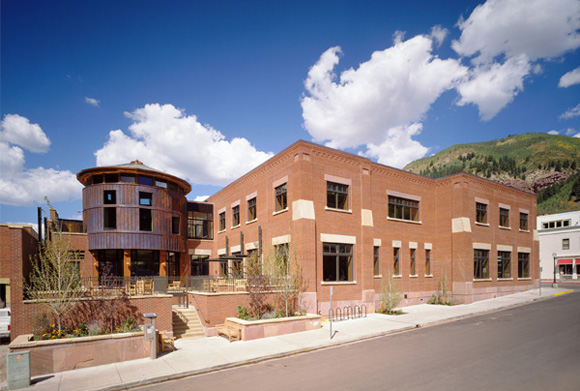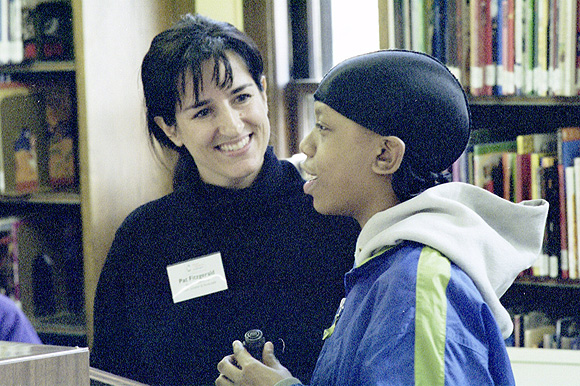
The design and construction of a new library, in any sized community, is an act of building social and educational capital. Today, patrons are rediscovering that libraries can be, as I refer to them, community-based learning palaces. Similar to the explosion of library construction at the turn of the 20th century, communities across the United States are building new libraries. Library Journal reports that in 2003, 4,066,276 square feet of new or renovated public libraries were built in the United States. There are 8,991 library systems in the U.S. (ranging from one library to a city/county-wide system). A town’s trust in the attitude, talent, and compassion of the library architect is crucial to the process of creating this lasting and essential building for its community.
Libraries are being conceived and realized as distinctive places for individual user groups, designed with retailing techniques in mind, constructed to enhance the experience for young and old alike, and being made extremely flexible and energy conservative. As stated by Dr. Alan Bundy, University Librarian, University of South Australia, “After all, the most enduring and flexible learning institution is the library—organized for well over two millennia and predating the first universities and schools by well over one millennium—to provide self-paced and self-selected transmission of knowledge.”
Social capital, as defined by James Coleman, Pierre Bordieu, and others, “is essentially the network of linkages, trust and bonds within a society that allow an individual to operate within a society that accrues advantages to that individual.” Successful libraries are responsive to their communities—creating services that are specifically tailored to their needs. As institutions, they are reasserting themselves as essential centers of learning and community exchange by creating this social capital in an intellectual marketplace. The size of a town or marketplace is defined by library systems as the population served per outlet. In California, 980 public library outlets (including branches, main libraries or bookmobiles) serve 33,000,000 people, for an average of 33,673 people per outlet.
As the intellectual heart and soul of a community, a library supplies the blood and nutrients specifically through its services. As defined by Amitai Etzioni in The Monochrome Society: “Community [has] two attributes: first, a web of affect-laden relationships that encompass a group of individuals—relationships that crisscross and reinforce one another, rather than simply a chain of one-on-one relationships . . . . This attribute will be referred to as bonding. Second, communities require a measure of commitment to a set of shared values, mores, and meanings and shared historical identity— in short, a culture.”
The library is at the heart of a social network that builds trust within the town through education. Besides informing its citizenry, it breaks down barriers and opens opportunities for communication. The public library remains one of the few places where people of all ages and backgrounds convene. As Lewis Lapham, Chair, Americans for Libraries Council, has said, “The security of the nation depends on knowledge and community; the library gives us both.” The library serves as the main institution that can facilitate community building and the creation of social capital.
In Bowling Alone, Robert Putnam writes that it is necessary for us to transcend our social, political, and professional identities to connect with people unlike ourselves. Libraries encourage these connections through their collections and the way they serve their communities. They also operate on many levels simultaneously. They can be meeting places, learning resources, and comfortable rooms to relax alone or visit with a friend, meet a group, teach a child, learn a new skill, research a stock or business, write a resume, find a car to buy, or pick up a form. The library and its programs can help reconcile competing interests within a community. In Better Together, Putnam notes that the Chicago Public Library “thrives today because it embodies a new idea of how a library functions. No longer a passive repository of books and information or an outpost of culture, quiet, and decorum in a noisy world, the new library is an active and responsive part of the community and an agent of change.” The design of the new Rancho Mirage Public Library, for example, creates spaces for concerts, outdoor activities, interpretive native plant gardens, and senior-friendly seating areas.
The duality of bonding and culture, as defined by Etzioni, fits well with what can be achieved in a town library. For example, the Bowling Green, Kentucky Public Library created a digital branch in a historic train depot. Many of the neighborhood children and adults who visit the library do not have the disposable income to enjoy the national upsurge in technological connectivity. This small branch is their primary technological link to the world. It is creating a wonderful mixing pot where people of different ethnic, social, and economic backgrounds are coming together for the first time. Since the library’s opening, crime has dropped and people are visiting the neighborhood, once thought of as off-limits because of its high crime rate.

A well-conducted public process can jump start a community’s trust in the architect. It can also expedite the development of trust among stakeholders, which can in turn help create linkages and social capital in the community. The architect is in a unique position to help build these linkages. For example, our architecture firm—Meyer, Scherer & Rockcastle (MS&R), based in Minneapolis—has conducted over 750 workshops over the past 22 years in more than 100 communities across the country, using the following processes to guide us through the library building process:
- Using an architectural “Rorschach test”—showing from 100- 200 library buildings from around the world—in public meetings. This exercise enables the architect to quickly discover the “aesthetic preferences” of a community. In such tests conducted by MS&R, the top vote getter for favorite building is the Academy of Arts and Science in Cambridge, Massachusetts, by Kallmann, McKinnell and Woods Architects.
- Creating a top-ten list of descriptive words from cards handed out at community meetings. The top-ten words from meetings that MS&R has facilitated with communities across the country are: 1) safe, 2) convenient, 3) comfortable, 4) warm, 5) inviting, 6) technology, 7) selection, 8) accessible, 9) rich in resources, and 10) meeting place. What stands out is the universality of community aspirations, from Delaware to Oklahoma to California. Skillfully interpreting these words into architectural meaning is one of the architect’s creative responsibilities.
- Meeting with children and teenagers after school. In 1995, there were 49 million five-to seventeen-year olds (the elementary and secondary school-aged population). By 2000, this group had grown to 22% of the population or 61.5 million. Lessons MS&R has learned from focus groups across the country include a) despite prevailing stereotypes, children and teens love the printed word; b) great social spaces in the library increase usage; and c) this age group desires spaces that are tailored to their needs, with such amenities as comfortable, lounge-type seating, space for collaboration and individual concentration, and available, but not too visible, service points. These listening sessions guide the architect in creating a place that is right in terms of scale, spirit, and functionality.
- Holding listening sessions for adults. For example, over a course of 40 community meetings, 2,000 people expressed their opinion on what the Fayetteville Public Library should and should not have. Among the should haves: a) coffee shop, b) plethora of printed materials, c) different sized study rooms, d) LEED™ certification, e) computer-free quiet zones, and e) wireless connectivity access.
Architects, in the eyes of some, seem more interested in the library building as an object created ex nihilo than as a mirror of the town’s self image. One of the dilemmas that an architect faces when designing a library is whether to capture a reflection of the town or the architect. Does the architect draw this image from the vocal few, the politicians who act on the funding, from the collective unconsciousness of the town, or their own point of view? Does the architect appear to be listening while trying to figure out how to communicate his or her personal design aspirations in terms of what he or she “hears”? In Main Street, Sinclair Lewis showed us that one main street is the continuation of main streets everywhere. Towns are shaped by the personal aspirations of well-intentioned people and destroyed by small-minded people who do not care to even darken the door of a library before declaring it irrelevant in the age of the Internet.
From Andrew Carnegie forward, it is often the library hero who makes the difference in the planning of the community library. For example, Mary Jean Place, an art dealer with a masters degree in library science living in Palo Alto, suggests that librarians become social activists. As a former member of the California Council of Library Trustees and cofounder of the Palo Alto Library Commission, she has worked for years to change the funding opportunities for libraries. Another notable advocate is Louise Schaper, director of the Fayetteville Public Library (previously with UCSD and ATT Bell Labs), who analyzed the library services from a financial point of view that illustrated the need for a new library in compelling and concrete economic terms to the civic government.
As architects, we can bring a similar, if less political, focus to the importance of the library by how well we conduct the design process and educate the public on the importance and potential of great library design—regardless of the size of the village, town, or city. Architects can emerge from the library design process as library heroes, if they exhibit exceptional courage, nobility, and strength, balancing their own needs with those of the community.
Author Jeffrey A. Scherer, FAIA, is a founding partner with Meyer, Scherer & Rockcastle, Ltd, in Minneapolis. He is past president of Minnesota AIA and the Library Foundation of Hennepin County, vice-chair of the Minneapolis Institute of Arts Paintings Council, and serves on the Americans for Libraries Council in New York. He has specialized in library programming, community building, technology, and design since 1977.
Originally published 2nd quarter 2004 in arcCA 04.2, “Small Towns.”





